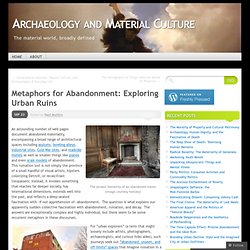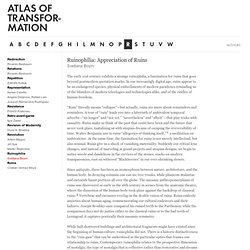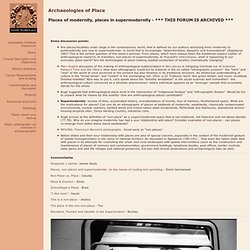

6 Forgotten Places, Rediscovered. Visiting these rooms, businesses, and homes is like traveling back in time. 1. The Old Operating Theatre Wikimedia Commons In 1822, there was no surgical anesthesia. Operations were performed quick and dirty right in a wealthy person’s home or, for poorer patients, in a hospital ward. 2. In 2010, the London Underground began upgrading their Notting Hill Gate station. 3. British Listed Buildings This thatched roof English cottage was likely quite a stately home when it was built in the 1400s.
“He just lived a basic life, with one cold tap in the scullery and the occasional bare light bulb to see by. 4. William Straw was a successful grocer at the start of the 20th century. 5. Imgur Earlier this year, Redditor Oktober75 posted to the r/pics sub-reddit something his family had discovered in a building they owned: an old shoe store, closed down in the 1960s, still fully stocked. 6. MessyNessyChic. Metaphors for Abandonment: Exploring Urban Ruins « Archaeology and Material Culture. The prosaic humanity of an abandoned manor (image courtesy howzey) An astounding number of web pages document abandoned materiality, encompassing a broad range of architectural spaces including asylums, bowling alleys, industrial sites, Cold War sites, and roadside motels as well as smaller things like pianos and even scale models of abandonment.

This ruination lust is not simply the province of a small handful of visual artists, hipsters colonizing Detroit, or recalcitrant trespassers; instead, it invokes something that reaches far deeper socially, has international dimensions, extends well into the past, and reflects a deep-seated fascination with—if not apprehension of—abandonment. The question is what explains our apparently sudden collective fascination with abandonment, ruination, and decay. The answers are exceptionally complex and highly individual, but there seem to be some recurrent metaphors in these discourses. The abandoned Spreepark near Berlin (image courtesy Norbert Lov). Metaphors for Abandonment: Exploring Urban Ruins « Archaeology and Material Culture. Fragments from a History of Ruin. Dimitrios Constantinou, The Temple of Zeus For the eyes that have dwelt on the past, there is no thorough repair.

—George Eliot, The Mill on the Floss 1. 2ª Guerra Mundial. O Outubro Alemão: A revolução perdida de 1923 Parte 1. Books about Berlin. Films to watch. Manuel Mozos nas ruínas das grandes esperanças. Ruins of the 20th Century. Berlim: Reconstrução Crítica. Ruinophilia: Appreciation of Ruins. The early 21st century exhibits a strange ruinophilia, a fascination for ruins that goes beyond postmodern quotation marks.

In our increasingly digital age, ruins appear to be an endangered species, physical embodiments of modern paradoxes reminding us of the blunders of modern teleologies and technologies alike, and of the riddles of human freedom. “Ruin” literally means “collapse”—but actually, ruins are more about remainders and reminders. Ruin'arte. Archaeologies of Place: Places of modernity, places in supermodernity - *** THIS FORUM IS ARCHIVED *** Some discussion points: Are places/localities under siege in the contemporary world, that is defined by our authors stretching from modernity to postmodernity and now to supermodernity- in world that is increasingly "deterritorilized, diasporic and transnational" (Appadurai 188)?

This is the central question of this week's seminar. From places, which have always been the traditional subject matter of anthropological research, to transitory non-places of supermodernity, to Foucault's heterotopias, what is happening to our everyday place-world? Are the technologies of place-making (spatial production of locality) dramatically changing? Berlin. Berlin This page will feature only a few of the sites associated with the capital of the Third Reich.

Those wishing further information should consult After the Battle's Berlin Then and Now, by Tony Le Tissier (London: Battle of Britain Prints, 1997 edition). Steven Spielberg Film and Video Archive. The Voice of the Survivors. Throughout our website the voices of the survivors infuse our online exhibitions, historical narratives, teaching units and ceremonies with content and with meaning.

We have gathered many of those testimonies in this section where they can be easily accessed by either topic or location. This section will continue to grow as more and more testimonies are added to the website. "For whoever listens to a witness becomes a witness" Excerpt from a speech given by Elie Wiesel at Yad Vashem. Abandoned Berlin. Mirrors: Tarkovsky & Derrida in Historical Ruins. Mirrors: Tarkovsky and Derrida in Historical Ruins The literal definition of history is as, ‘an aggregate of past events and human affairs’ and ‘the events forming the subject matter of a historical account’.

Consequently, if a photographic image is verifiably a ‘certificate of presence’ or ‘that-has-been’ as Roland Barthes avows in Camera Lucida, then is all photography, and by logical extension the motion of enjoined photographic images that is cinema, not history in its purest forms? Lynne Hunt’s essay ‘History as Gesture’ supplies the central dialectic of my enquiry – one that understands these central definitions of history, and extends into a discourse on historical representation: ‘History is a search for truth that always eludes the historian but also informs (her) work, but this truth is not an objective one in the sense of a truth standing outside the practices and concerns of the historian’.
Like this: Like Loading...